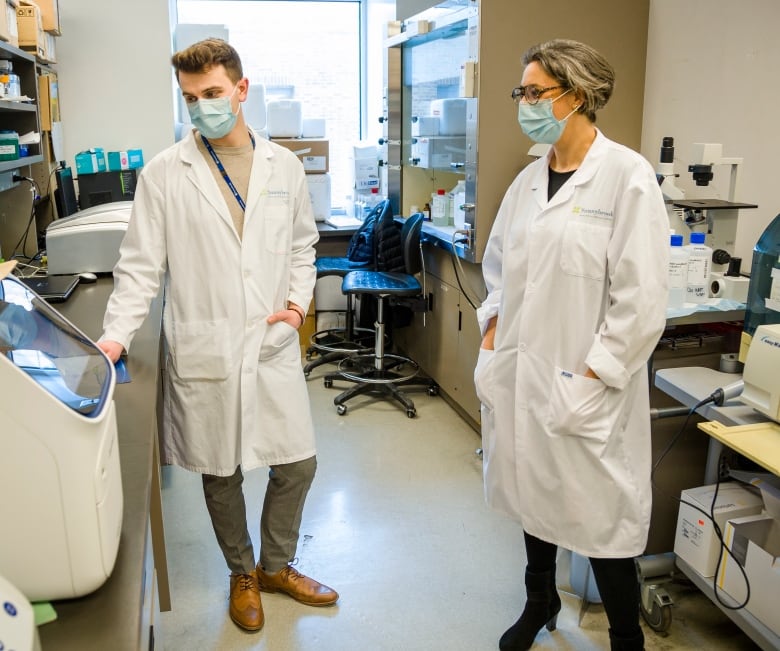Canadian researchers discover 1st possible case of deer spreading COVID-19 virus to a human
Animal-to-human transmission is rare, but people in close contact with wild deer should be cautious

In a world first, preliminary research suggests deer may be able to transmit the COVID-19 virus to humans, following analysis by ateam of Canadian scientists monitoring the spread of SARS-CoV-2 in animals.
Up until now, researchers have only found evidence of humans spreading the virus to deer, and deer spreading it to other deer.
New evidence suggesting the virus may be able to spill from deer to humans is asignificant development, as scientistsare closely trackingwhether wild animals could become a source of new variants and act as a reservoir for SARS-CoV-2.
Still, humans remain themain source of the virus and itsspread around the world.
The new research paperposted Friday on bioRxiv, anonline archive and distribution service for unpublished preprints in the life sciences,has notbeenpeer reviewed.
The findings stem from workby a team of scientistswho collaborated to analyze samples taken from hundreds of deer killed by hunters in the fall of 2021 in southwestern Ontario.
In their analysis, scientistsdiscovered ahighly divergent lineage of SARS-CoV-2 which essentially means a cluster of the virus with a lot of mutations.
Around the same time, a genetically similar version of the virus was identified in a person from the same region of Ontario who had recently been incontact with deer.
These were all sampled from Southwestern and Eastern Ontario with the help of hunters. We found 17/298 sampled deer positive for SARS-CoV-2 (all from Southwestern Ontario) via nasal swabs and lymph node samples (checking carefully for contamination) /2 pic.twitter.com/XNVsByaSsC
—@FinlayMFinlay Maguire, who collaborated on the research and helped analyze the genetic sequencing, underscored the fact no other caseswere found in humans.
"This particular case, while raising a red flag, doesn't seem to be hugely alarming," Maguire said in an interview.
He saidtheir conclusions comedown to strong circumstantial evidence.
"While we haven't seen [transmission from deer to human] happen directly,we sampled from the human case around the same time we sampled from the deer, and we sampled from around the same location," Maguire said. "There is also a plausible link by which it could have happened, in that the individual involved is known to have had considerable contact with deer."
The research points to the need for bettersurveillance of the COVID-19 virusnot just in humans, but also in animals, plants and the wider environment, said Maguire, an assistant professor at DalhousieUniversity and a pathogenomicsbioinformaticslead at the Shared Hospital Laboratory in Toronto.
Need for better surveillance
How the deer caught the virus in the first place is unclear, which is one of the reasons Maguire and others say more surveillance is needed.
It could have been transmitted from humans directly, or through wastewateror an intermediary host animal, like mink.
Together, this is suggestive of a virus that has diverged unobserved over 1-2 years (likely in association with deer). Given a possible deer-to-human transmission, it is important we evaluate possible reservoirs and adopt One-health approaches in our SARS-CoV-2 surveillance. /end pic.twitter.com/8mILYJtiMu
—@FinlayMSamira Mubareka, an infectious disease physician and virologist at Toronto's Sunnybrook Health Sciences Centre, also spoke to CBC and said the version of the virus they found was different from what's circulating now.
"It's not even closely related to Delta or to Omicron. It's most recent relative was from way back in 2020."
Mubareka, one of the authors of the research paper, said that means it took time for the divergent lineage to mutate and emerge.
"It's reassuring that we found no evidence of further transmission, during a time when we were doing a lot of sampling and a lot of sequencing," said Mubareka, amicrobiologist and clinical scientist at Sunnybrook Health Sciences Centre.
"If we continue to do this surveillance, we'll get a much better sense of what the actual risk is."
Previously, the only other known cases of transmission from animals to humans have beenin farmed mink. There is also some preliminary research out of Hong Kong suggestingthe virus may be able to spread from hamsters to humans.

Hunters should be cautious
For most people, the risk of catching the virus from a human is much higher than catching it fromdeer.
The Public Health Agency of Canada (PHAC) said there is no evidence that animals play a large role in the current spread of COVID-19and animal-to-human transmission is rare, but the agency is warning hunters to be cautious.
Hunters and people who handle wild deer are being advised to wash their hands regularly, wear gloves, goggles and a well-fitted mask when there is a possibility of being exposed to respiratory tissues and fluids, especially indoors.
Coronaviruses are killed by normal cooking temperatures and there has been no evidence that cooked venison can spread the COVID-19 virus.
PHAC said scientists from the National Microbiology Laboratory reviewed the research paper's findings and confirmedthe genetic similarities suggest the possibility of deer-to-human transmission in this case.
"Based on available information to date, there is no sign of additional human infections with this unique sequence, since this single human case was identified," a statement from PHAC said.
"Routine genomic surveillance will continue to monitor positive PCR[polymerase chain reaction] test results for unusual variations of the virus in Canada, including this one."
So far, the virus has been found in wild white-tailed deer in the northeastern United States, as well as inQuebec,Ontario,Saskatchewanand Manitoba.












_(720p).jpg)


 OFFICIAL HD MUSIC VIDEO.jpg)
.jpg)



























































































